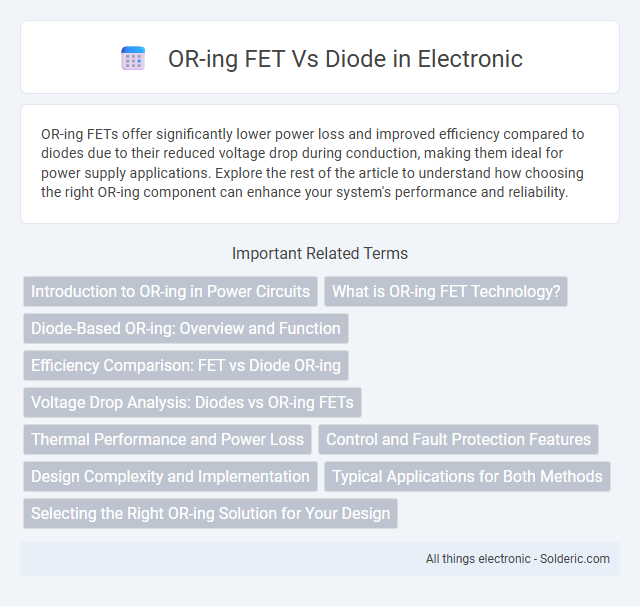OR-ing FETs offer significantly lower power loss and improved efficiency compared to diodes due to their reduced voltage drop during conduction, making them ideal for power supply applications. Explore the rest of the article to understand how choosing the right OR-ing component can enhance your system's performance and reliability.
Comparison Table
| Feature | OR-ing FET | Diode |
|---|---|---|
| Function | Active OR-ing for power path control | Passive current blocking |
| Voltage Drop | Low R_DS(on), minimal voltage drop (~mV) | Higher forward voltage drop (~0.7V for silicon diode) |
| Efficiency | High efficiency, reduced power loss | Lower efficiency, increased heat dissipation |
| Reverse Leakage | Very low leakage current | Usually higher leakage current than FET |
| Complexity | Requires control circuitry | Simple, no control needed |
| Cost | Higher cost due to active components | Low cost |
| Thermal Performance | Better thermal management due to lower loss | Worse thermal due to power dissipation |
| Use Case | High-efficiency power paths, battery backup systems | Simple reverse polarity protection |
Introduction to OR-ing in Power Circuits
OR-ing in power circuits ensures seamless power source switching and redundancy by allowing multiple voltage sources to supply a load without interference. Using FETs for OR-ing provides low forward voltage drop and higher efficiency compared to traditional diodes, reducing power loss and heat generation. Your choice between FET and diode OR-ing impacts system reliability, efficiency, and thermal management significantly.
What is OR-ing FET Technology?
OR-ing FET technology uses MOSFETs to perform power path control by allowing current to flow in one direction while minimizing voltage drop and power loss compared to traditional diodes. This approach enhances efficiency and thermal performance in power supply circuits, especially in redundant power systems. Your designs benefit from faster response and lower conduction losses, improving overall reliability and energy savings.
Diode-Based OR-ing: Overview and Function
Diode-based OR-ing circuits use diodes to connect multiple power sources, allowing current flow from the highest voltage source while blocking reverse current from others. This method provides a simple and cost-effective way to ensure power redundancy and prevent backfeed between sources. Your system benefits from reliable source selection without complex control circuitry, though it incurs voltage drop and power loss due to the diode's forward voltage.
Efficiency Comparison: FET vs Diode OR-ing
FET OR-ing offers significantly higher efficiency than diode OR-ing due to its lower forward voltage drop, reducing conduction losses and improving power delivery in high-current applications. Diode OR-ing suffers from inherent voltage drops ranging from 0.3V to 0.7V for Schottky and silicon diodes, respectively, leading to wasted energy and heat. Your system benefits from FET OR-ing by achieving cooler operation and improved overall power efficiency, particularly in sensitive or high-performance electronic designs.
Voltage Drop Analysis: Diodes vs OR-ing FETs
OR-ing FETs exhibit significantly lower voltage drop compared to diodes, enhancing power efficiency in systems by reducing conduction losses. While diodes typically have a forward voltage drop of 0.7V for silicon types or 0.3V for Schottky types, OR-ing FETs can achieve drops as low as a few millivolts due to their low on-resistance (R_DS(on)). This lower voltage drop in OR-ing FETs improves overall system thermal performance and extends battery life, making them preferable for maintaining your device's reliability and efficiency.
Thermal Performance and Power Loss
OR-ing FETs deliver superior thermal performance compared to diodes due to their lower on-resistance (R_DS(on)), resulting in significantly reduced conduction losses and heat generation. Diodes inherently have a fixed forward voltage drop, typically around 0.7V for silicon types, causing higher power dissipation during conduction, especially under high current conditions. Optimizing thermal management with OR-ing FETs enhances system efficiency and reliability by minimizing power loss and reducing the need for extensive heat sinking.
Control and Fault Protection Features
OR-ing FETs offer superior control and fault protection features compared to diodes, enabling lower voltage drops and enhanced efficiency in power path management. These devices incorporate built-in control logic for smooth switching and rapid fault detection, reducing energy loss and minimizing thermal stress. Diodes, lacking active control, exhibit higher forward voltage drops and limited fault handling capabilities, often resulting in increased heat generation and lower system reliability.
Design Complexity and Implementation
OR-ing FETs offer lower design complexity by integrating control within the transistor, reducing the need for additional components compared to diode-based OR-ing circuits that require multiple discrete parts. Implementation of OR-ing FETs simplifies PCB layout and improves efficiency due to lower voltage drop and heat dissipation, whereas diode-based designs often demand heat sinks and larger footprints. Your choice of OR-ing FETs can streamline power management design while enhancing system reliability and thermal performance.
Typical Applications for Both Methods
OR-ing FETs are commonly used in high-efficiency power systems such as server power supplies, telecommunications, and battery backup systems where low voltage drop and fast switching are critical. Diodes, especially Schottky diodes, are favored in simpler applications like low-cost power protection, reverse polarity prevention, and basic redundancy in automotive and consumer electronics. Your system choice depends on efficiency needs and cost constraints, with FET OR-ing excelling in high-performance scenarios and diodes offering reliability in budget-sensitive environments.
Selecting the Right OR-ing Solution for Your Design
Selecting the right OR-ing solution involves comparing FETs and diodes based on efficiency, voltage drop, and thermal performance. FET OR-ing provides lower conduction losses and faster switching, ideal for high-current, high-efficiency designs, while diode OR-ing is simpler and more cost-effective but suffers from higher forward voltage drop. Your choice impacts overall system reliability and power management, making careful evaluation of load conditions and efficiency requirements essential.
OR-ing FET vs Diode Infographic

 solderic.com
solderic.com